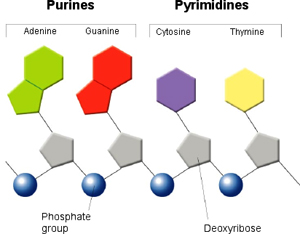DNA Structures
DNA (Deoxyribonucleic Acids) Store and transmit genetic information. It is made from a String of Nucleotides.

The Pentagon shape is a five carbon sugar which is deoxyribose. There is a phosphate group which are the circles off to the sides. Lastly there is a nitrogen base ( Adenine, Thymine, Guanine, and Cytosine).
Adenine is always paired with Thymine
Guanine is always paired with Cytosine
Both of these bases are connected by hydrogen bonds.
There is a sugar/ Phosphate backbone which make up the outside of the DNA molecule.
Purines and Pyrimidines
Adenine and Guanine are the Purines. The pyrimidines are Thymine and Cytosine.
 |
James Watson and Franklin Crick are the men who discovered the double helix.Some people who had some Important discoveries are:
Another very important person is Rosalind Franklin who devoted her life to finding out as much as she could about DNA structures using x-rays. Her work eventually led to the double helix.
Adenine pairs with Thymine***Remember: Erwin Chargaff's Base-Pairing Rules:
Cytosine pairs with Guanine
These bases pair together because they are similar in chemical composition.%A = %T
%C = %G










